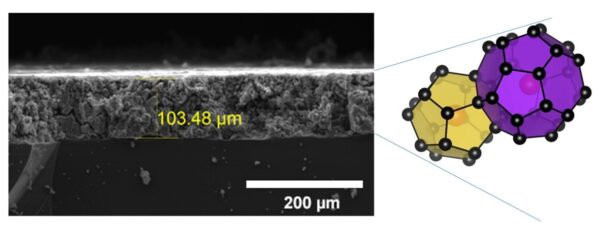Several forms of silicon are commonly used in the PV industry – amorphous, polycrystalline, and monocrystalline. Although the photovoltaic market is dominated by crystalline silicon solar cells, alternative materials are being investigated.
The requirements for these materials are the abundance of their chemical elements, as well as stability, low toxicity, ease of fabrication and potential for high conversion efficiencies. Silicon, on the other hand, is the second most abundant element on Earth.
While the bandgap of diamond silicon is fixed at around 1.1 eV, exotic forms of silicon could provide an alternative. For example, silicon clathrates are based on silicon cages with a guest atom inside, often sodium (Na), that can be almost completely removed from the cages. The bandgap of Type II silicon clathrate is direct and its energy is about 1.8 eV making it quite ideal for silicon tandem solar cells.
While silicon clathrate fabrication routes were discovered in the form of powders in the 1960s, their development was hindered by the lack of a film fabrication process. This has been enabled in the last years by at least three groups, Gifu University in Japan, Colorado School of Mines and National Renewable Energy Laboratory (NREL) in the United States, as well as CNRS research labs ICube/IPCMS and INL.
A recent development from CNRS within a national research project has allowed a drastic improvement in film quality, thanks to a thermal press annealing process. This breakthrough has for the first time allowed an Atomic Force Microscopy image to be recorded on silicon clathrate films.

Image: French National Centre for Scientific Research
Another development from CNRS-ICube consists of the surface photovoltage measurements (SPV) of silicon clathrate films with different Na occupancy inside the cages. This occupancy can be monitored using Energy Dispersive X-ray Spectroscopy and analyzed through X-ray diffraction patterns.
Other researchers found that as-grown samples have a composition of about Na4Si136, a Na0.1Si136 film with much less Na can be obtained by a chemical treatment with iodine. Other works showed that semiconductor and photovoltaic properties are greatly enhanced with very low Na occupation.
More recently, prototype p-n heterojunction devices with metal oxides based on silicon clathrate films were fabricated and tested. A rectification was demonstrated paving routes for potential applications.

Image: French National Centre for Scientific Research
Indeed, in addition to the possible use of silicon clathrates as solar cell devices, there is significant potential for cross-fertilization of the discoveries for other fields such as anodes for batteries, hydrogen storage, and thermoelectricity.
Authors: T. Fix, C. Tamin, A. Bharwal, C. Chevalier, S. Roques, R. Vollondat, A. Dinia, A. Slaoui
This article is part of a series contributed by RD20, a global initiative of leading research institutes of the G20 countries with the aim to strengthen international collaboration in R&D and promote innovation towards a carbon-neutral society. Articles under this column are contributed by individual RD20 member institutes and are the sole property of the designated author(s).
For more information: https://rd20.aist.go.jp/
The views and opinions expressed in this article are the author’s own, and do not necessarily reflect those held by pv magazine.
This content is protected by copyright and may not be reused. If you want to cooperate with us and would like to reuse some of our content, please contact: editors@pv-magazine.com.



By submitting this form you agree to pv magazine using your data for the purposes of publishing your comment.
Your personal data will only be disclosed or otherwise transmitted to third parties for the purposes of spam filtering or if this is necessary for technical maintenance of the website. Any other transfer to third parties will not take place unless this is justified on the basis of applicable data protection regulations or if pv magazine is legally obliged to do so.
You may revoke this consent at any time with effect for the future, in which case your personal data will be deleted immediately. Otherwise, your data will be deleted if pv magazine has processed your request or the purpose of data storage is fulfilled.
Further information on data privacy can be found in our Data Protection Policy.